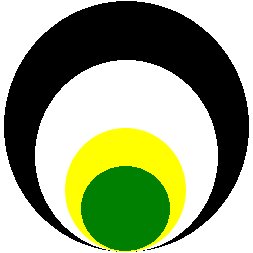
Mother Church * Church of the Mother
Mother and Sons
Tracing the relationship between "Mother and Sons", several stages can be distinghuished. In "the beginning" there was only the Mother, the Cosmic Womb. Without any "help from outside" She gave birth to a Divine Son, who subsequently became Her lover *. "As part of creation", the Son represented the natural "cycle of birth and death". Hence, in the earliest times the Son - for the sake of his people - had to be sacrified, in order for nature to be reborn. He - the savior - became the hero, who voluntarily went into the underworld. Through this ritual the cycle of life - of "birth and death" - the vegetation was secured. It is corresponding with the modern situation, in which - in order to survive - we have to "die to the old".
In reality, holy marriages ("hieros gamos") took place, in which one or more men publicly made love to the Mother-Queen, after which they were ritually killed. The Mother had to obey the natural Law - since She was the source of it - while simultaneously mourning about the loss of Her Son/Lover. Sometimes, She became so overwhelmed with grief **, that She started searching for him in the underworld (Inanna, Isis). A few months later, the rebirth took place, reason for extensive celebration, since the fertility of the soil had been guaranteed. In a later stage in history, the Son appears to have become king at the grace of the Mother (Babylon). In the myths not he, but a (more) representative(s) is (are) killed. It leads to the images of the vegetation gods, the "green men". In still later stages, the Queen-goddess turns into the god-king's mistress.*** Finally, the "only God" is ruling all by himself (Jaweh). The feminine principle partly went underground, partly turned up in a new - mostly distorted - image.
* See how patriarchy has just changed the fact into the opposite: the creation of Eve out of the rib of Adam (Genesis).
** Compare the mourning of the Great Mother with the Christian "pieta", with Maria sitting with her dead son on her lap.
*** Which has its counterpart in the Gnostic/Biblical Sophia (Wisdom), the feminine "consort of God". Note the change from the original "God born out of the Mother" into its opposite: "Wisdom-Sophia created by God".
At some places matriarchy - together with the slaughtering of men - could have lasted for many millennia! It is the explanation for the fact, that to men "escaping from the cycle of birth and death" became a main obscession. It is the driving force behind the longing for Transcendence, as well as the beginning of patriarchy. It is astonishing to find this common denominator in most patriarchal religions. In Hinduism, all effort is focused on escaping from karma, so as to "prevent coming back" on this earth again. In Buddhism, "escaping from the cycle of birth and death" is the underlying principle, on which everything else is based. In Christianity, "Christ has redeemed us from our sins" (of "nature"), so that every Christian will be reborn in "the kingdom of heaven". Islam is very similar. A true believer "will not return to the darkness of the womb", but will be united with Allah in paradise. Fear of returning to the Womb appears to be the common denominator. In psychology (E.Neumann), it is defined as the fear of the (masculine) ego of "falling back" into the darkness of the unconscious. Hence, the compulsory masculine striving for "progress".